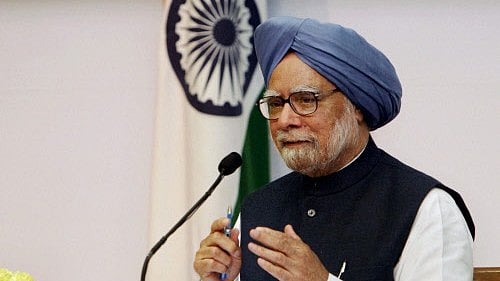
Manmohan Singh's Budget in 1991 is a landmark in Indian financial history.
Credit: PTI File Photo
The major announcement of increasing the ‘nil’ income tax slab from Rs 7 lakh to Rs 12 lakh will provide relief to the much-aggrieved middle class. We must see how people respond to these tax cuts.
The second Donald Trump US presidency has created a storm in economies and financial markets around the world by disrupting the earlier world order of trade integration and harmony.
India’s economy has also slowed down with growth rates dipping to 6-7% from the 8+% levels post-pandemic. There was a need for a Budget which looks at the Indian economy given these global challenges. In a way, the timing of the Budget was similar to the one presented in 1991 by then Finance Minister Manmohan Singh. Apart from India facing an economic crisis, the world order was also changing from socialism to capitalism.
The Budget Speech started by acknowledging the global challenges, saying that “geopolitical headwinds suggest lower global economic growth over the medium term”. However, it dismissed the challenges by adding that “the transformative work done by the government over last two terms continue to guide us to march forward resolutely”. Any government is expected to express confidence by looking at its past record. But to link today’s global challenges to the last two terms is like driving a car by looking at the rear mirror!
The government should have listed the global challenges, and how it plans to address these. This is a bare minimum from any government which itself says in the Budget that “we embark on a journey to unlock our nation’s tremendous potential for greater prosperity and global positioning”.
The LPG (Liberalisation, Privatisation, and Globalisation) framework that became popular due to the 1991 reforms can be applied to understand the February 1 Budget.
On liberalisation, the Economic Survey 2024-2025 tabled on January 31 emphatically argued that the philosophical approach of a good governance is governments ‘getting out of the way’ of businesses. Finance Minister Nirmala Sitharaman announced reforms on different sectors such as taxation, power, urban development, financial sector, etc. On taxation, the government will ‘trust first, scrutinise later’ in tax assessments. On the financial sector, Foreign Direct Investment in insurance is proposed to increase from 74% to 100%. On power, the government plans to incentivise electricity distribution reforms. On urban reforms, there is proposal to shape cities as growth hubs, which appears similar to the smart cities project. The government has also proposed a high-level committee to review all regulations in the non-financial sector. It must be seen how these reforms play out.
On privatisation, there is no major thrust. The disinvestment target has been revised from Rs 50,000 crore in 2024-2025 to Rs 47,000 crore in 2025-2026. On globalisation, the government has removed seven tariff rates and removed basic customs duty (BCD) on some critical lifesavings drugs.
The major announcement of increasing the ‘nil’ income tax slab from Rs 7 lakh to Rs 12 lakh will provide relief to the much-aggrieved middle class but inflation has also risen negating the gains. We must see how people respond to these tax cuts. Even earlier corporate tax cuts did not lead to desired increase in private investments.
This Budget has many schemes focused on Bihar, and this has led to the impression that the government is using the Budget to score political points, because the state will be going to the polls later in the year. This automatically weakens democracy, giving huge advantage to the ruling party.
Finally, the finance minister missed a big opportunity by not acknowledging late Manmohan Singh’s contributions in her Budget Speech. It was always a tall order given Singh was an Opposition leader, but these are exactly the moments when we must break political barriers and become greater human beings.
Amol Agrawal is an economist teaching at Ahmedabad University.